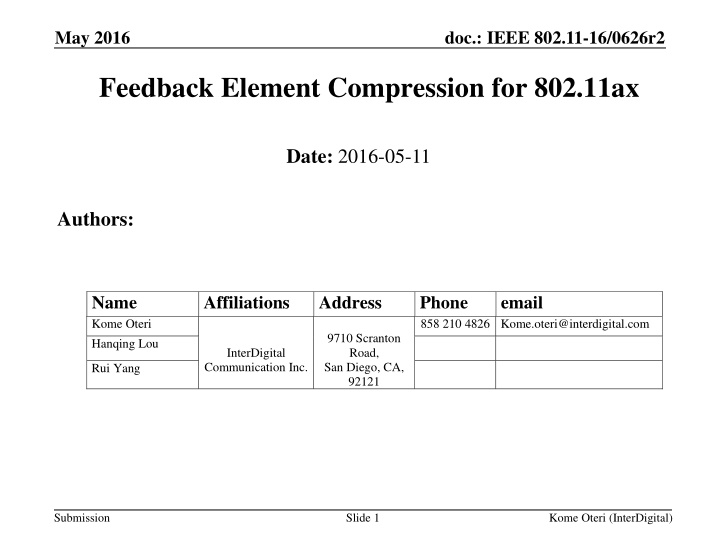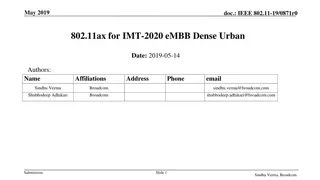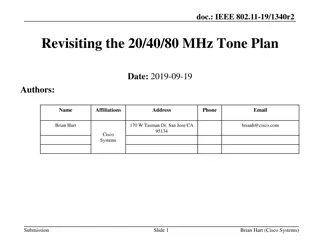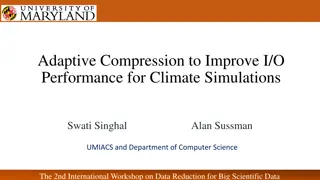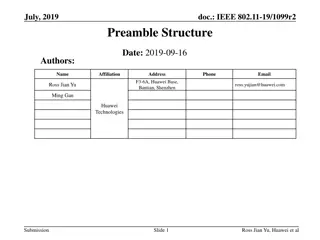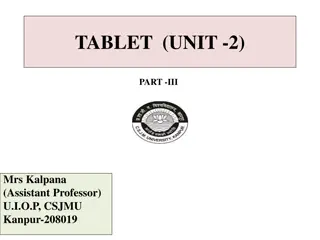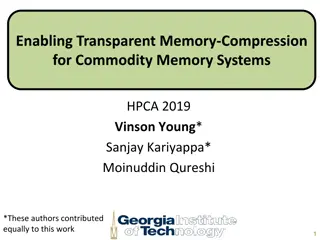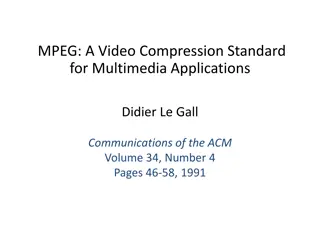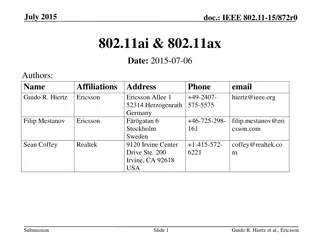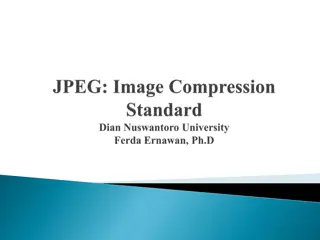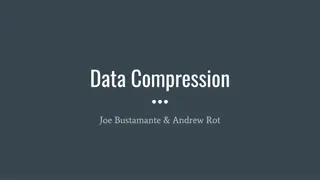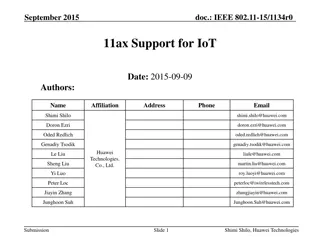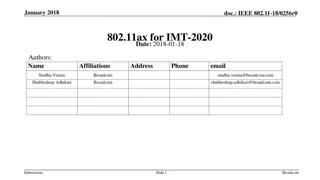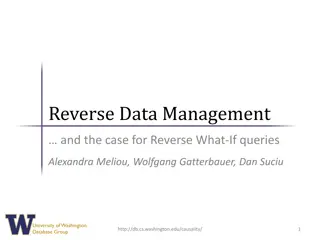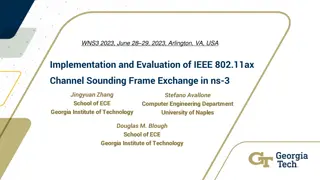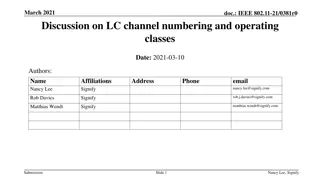IEEE 802.11ax Feedback Element Compression
In this document, methods to reduce the overhead of explicit MIMO compressed beamforming feedback in IEEE 802.11ax are discussed. The current agreements, further compression schemes, and potential savings in feedback are highlighted.
Download Presentation

Please find below an Image/Link to download the presentation.
The content on the website is provided AS IS for your information and personal use only. It may not be sold, licensed, or shared on other websites without obtaining consent from the author.If you encounter any issues during the download, it is possible that the publisher has removed the file from their server.
You are allowed to download the files provided on this website for personal or commercial use, subject to the condition that they are used lawfully. All files are the property of their respective owners.
The content on the website is provided AS IS for your information and personal use only. It may not be sold, licensed, or shared on other websites without obtaining consent from the author.
E N D
Presentation Transcript
May 2016 doc.: IEEE 802.11-16/0626r2 Feedback Element Compression for 802.11ax Date: 2016-05-11 Authors: Name Kome Oteri Hanqing Lou Affiliations InterDigital Communication Inc. Address Phone 858 210 4826 Kome.oteri@interdigital.com email 9710 Scranton Road, San Diego, CA, 92121 Rui Yang Submission Slide 1 Kome Oteri (InterDigital)
May 2016 doc.: IEEE 802.11-16/0626r2 Outline Introduction Current Agreements Further Compression Schemes Conclusion Submission Slide 2 Kome Oteri (InterDigital)
May 2016 doc.: IEEE 802.11-16/0626r2 Introduction In this contribution, we discuss methods to further reduce the overhead of explicit MIMO compressed beamforming feedback in 802.11ax. 802.11ac supports explicit MIMO compressed beamforming feedback with (4,2) or (6,4) bits to quantize angle ( , ) for single user, and (7,5) or (9,7) bits to quantize angle ( , ) for multi-user. In [7], we discussed possible methods to reduce explicit MIMO compressed beamforming feedback overhead in 802.11ax. Current agreements have adopted the following [7][8]: 1. Large Ng: Increase the tone grouping size {Ng} during feedback [3][4] 2. Multi-resolution/Multi-stage feedback: Identify frequency band(s)/Resource Units (RU(s)) based on scalar feedback (e.g. SNR/CQI) and feed back full CSI for desired frequency band /RU(s). In this contribution, we highlight methods that may result in additional feedback savings. Submission Slide 3 Kome Oteri (InterDigital)
May 2016 doc.: IEEE 802.11-16/0626r2 Current Agreements The specification framework [1] has the following agreements: The amendment shall define a channel sounding sequence (Figure 22) initiated by an HE AP that includes a Trigger frame that is sent SIFS after the NDP frame in order to solicit UL MU mode of Compressed Beamforming Action frame from multiple HE STAs [MU Motion 18, September 17, 2015, see [9], modified with MU Motion 37, November 2015, see [9]] The amendment shall define a mechanism to reduce the MIMO compressed beamforming feedback overhead [MU Motion 25, September 17, 2015, see [10]] That mechanism shall use the compressed beamforming feedback as defined in section 8.4.1.48 in 802.11ac as a baseline [PHY Motion 100, November 2015] Submission Slide 4 Kome Oteri (InterDigital)
May 2016 doc.: IEEE 802.11-16/0626r2 Current Agreements Agreements (ctd) A channel quality indicator only (CQI-only) feedback (exact metric TBD) will be supported by the sounding protocol in 11ax. The request for CQI- only feedback goes in NDPA [PHY Motion 152, March 2016, see [8]] AP can request beamforming feedback over partial BW which is less than the NDP BW. The indication of the feedback BW goes in NDPA [PHY Motion 148, March 2016, see [8]] The granularity of channel feedback requested by the AP is a 26 tone RU. The AP signals start and end 26 tone RUs requested for feedback [PHY Motion 149, March 2016, see [8]] Submission Slide 5 Kome Oteri (InterDigital)
May 2016 doc.: IEEE 802.11-16/0626r2 Further Compression Schemes The current agreements reduce the feedback overhead by structural changes to the feedback mechanism but do not address savings that may be gained by changing the feedback elements themselves. Examples of this include: 1. Only Feedback: Feed back only in N x 1 transmission and assume a fixed [5] 2. Variable Angle Quantization : Use different quantization levels for different Given s rotation angles ( i, i). 3. Differential Given s Rotation : Feed back time or frequency difference in Given s Rotation angles [6] Submission Slide 6 Kome Oteri (InterDigital)
May 2016 doc.: IEEE 802.11-16/0626r2 Extension Scheme (1) 1. Only Feedback: Feed back only in N x 1 transmission and assume a fixed [5] 802.11ah supports feedback of ? angles only with single data stream transmissions. The values of are fixed [5, 24.3.10.2] Reduction in overhead is shown in the tables below (methodology in appendix) We may keep the overhead the same and increase b . (Table 1 and 2) We may reduce the overhead by keeping b the same and changing b (Table 1 and 3) Submission Slide 7 Kome Oteri (InterDigital)
May 2016 doc.: IEEE 802.11-16/0626r2 Extension Schemes (2) 2. Variable Angle Quantization : Use different quantization levels for different Given s rotation angles ( i, i). Angle may vary over the distribution; for example range of 1is greater than range of 7 for 8 x 8 system shown below. To quantize the angles after Givens rotation, we may use different ranges for different angles or groups of angles. For each angle or groups of angles, the range = ?,? 0,?/2 . Kome Oteri (InterDigital) Submission Slide 8
May 2016 doc.: IEEE 802.11-16/0626r2 Extension Schemes (3) 3. Differential Given s Rotation : Feed back time or frequency difference in Given s Rotation angles Send differential information between Given s rotation angles of baseline channel and next channel in time [6] or frequency May use scalar difference (subtraction) or vector difference (range/null space overlap). H(k) {f(k), y(k)} Givens decomp. Original quantization - H(k+4) {df, dy} {f(k+4), y(k+4)} Givens decomp. Differential quantization + Empirical CDF Empirical CDF 1 1 Channel B+D+E Channel B only 0.9 0.9 0.8 0.8 0.7 0.7 0.6 0.6 F(x) F(x) 0.5 0.5 0.4 0.4 Channel B+D+E Channel B only 0.3 0.3 0.2 0.2 0.1 0.1 0 0 -0.5 -0.4 -0.3 -0.2 -0.1 0 0.1 0.2 0.3 0.4 0.5 -1 -0.8 -0.6 -0.4 -0.2 0 0.2 0.4 0.6 0.8 1 radians radians ?? is approximately distributed within the range of ?/2,?/2 ?? 0,2? ?? is approximately distributed within the range of ?/8,?/8 vs 0,?/2 Kome Oteri (InterDigital) Submission Slide 9
May 2016 doc.: IEEE 802.11-16/0626r2 Summary (Pros and Cons) Submission Slide 10 Kome Oteri (InterDigital)
May 2016 doc.: IEEE 802.11-16/0626r2 Conclusions Current agreements in 802.11ax have reduced the feedback overhead compared with 802.11ac Further feedback overhead reduction may be achieved by modifying the explicit feedback elements themselves using 802.11ac feedback as a baseline. The performance of these methods should be studied and a combination of them adopted in 802.11ax Submission Slide 11 Kome Oteri (InterDigital)
May 2016 doc.: IEEE 802.11-16/0626r2 References 1. 2. 3. 4. 5. 6. 11-15-0132-09-00ax-spec-framework 11-15-1129-01-00ax-feedback-overhead-in-dl-mu-mimo 11-15-1071-02-00ax-tone-grouping-factors-and-ndp-format-for-802-11ax 11-15-1320-00-00ax-Maximum-tone-grouping-for-802_11ax-feedback IEEE P802.11ah /D2.0 Amendment 6: Sub 1 GHz License Exempt Operation Porat, R.; Ojard, E.; Jindal, N.; Fischer, M.; Erceg, V., "Improved MU-MIMO performance for future 802.11 systems using differential feedback," in Information Theory and Applications Workshop (ITA), 2013 , vol., no., pp.1-5, 10-15 Feb. 2013 11-15-1321-02-00ax-Reducing Explicit MIMO Compressed Beamforming Feedback Overhead for 802.11ax, Kome Oteri (InterDigital) 11-16-0389-01-00ax-sounding-design, Sriram Venkateswaran (Broadcom) 11-15-109-01-00ax Reducing Channel Sounding Protocol Overhead for 11ax, Narendar Madhavan (Toshiba), 11-15-1129-01-00ax Feedback overhead in DL-MU-MIMO , Filippo Tosato (Toshiba), 7. 8. 9. 10. Submission Slide 12 Kome Oteri (InterDigital)
May 2016 doc.: IEEE 802.11-16/0626r2 Straw Poll #1 Do you agree to add the following to section 4.6 of the SFD ? 802.11ax shall provide mechanisms that compress the feedback elements/angles ( , ) of compressed beamforming feedback as defined in section 8.4.1.48 in 802.11ac. Y/ N/ A Submission Slide 13 Kome Oteri (InterDigital)
May 2016 doc.: IEEE 802.11-16/0626r2 Overhead Calculation Details VHT Compressed Beamforming frame is utilized for CSI feedback. Frame Size = MAC Header size + VHT Compressed BF frame Action field size VHT Compressed Beamforming frame action field format VHT Compressed BF Report Average SNR per stream Angles {?,?} compressed from V matrices per Ng subcarriers Number of angles reported depend on the size of V matrices. Number of bits for ? and ?, ?? and ??, are determined by VHT MIMO Control field. Submission Slide 14 Kome Oteri (InterDigital)
